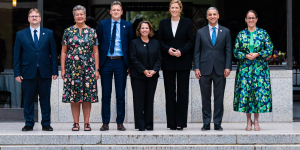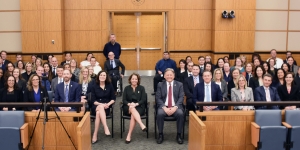Speech
Deputy Attorney General James Cole Delivers Remarks at Press Conference Announcing Anadarko Litigation Settlement
Location
United States
Good afternoon and thank you all for being here. Today, I am joined by the United States Attorney for the Southern District of New York, Preet Bharara, the Acting Assistant Attorney General of the Justice Department’s Environment and Natural Resources Division, Bob Dreher, and Environmental Protection Agency Assistant Administrator Cynthia Giles.
We are here to announce a $5,150,000,000 settlement with the Kerr-McGee Corporation and its parent company Anadarko Petroleum. This settlement is the largest recovery for cleanup of environmental contamination in the history of the Department of Justice. Pursuant to the settlement agreement, approximately $4,400,000,000 will fund environmental clean-up and settle environmental claims across the United States. It represents another critical step forward in our ongoing efforts to fight corporate misconduct and to remedy the health, safety, and economic consequences of environmental contamination.
For 85 years, Kerr-McGee operated numerous hazardous businesses, and those businesses caused significant damage to the environment and to communities exposed to contamination. Kerr-McGee’s perchlorate business contaminated Lake Mead, which flows into the Colorado River and provides drinking water to much of the Southwest United States. Its uranium mining operations left abandoned mines with radioactive waste piles throughout the territory of the Navajo Nation. Its wood treating facilities left carcinogenic creosote contamination throughout the East, Midwest, and South, and its thorium facilities left radioactive soil in the City of Chicago. All told, dozens of sites were dangerously contaminated. Over time, Kerr-McGee was found liable for the cost of cleaning up these sites and compensating those with injuries resulting from exposure to contamination.
By the late 1990s, Kerr-McGee was no longer actively engaged in the businesses that had produced most of these environmental and tort liabilities. These “legacy” liabilities depressed Kerr-McGee’s stock value and its prospects for engaging in corporate mergers. So Kerr-McGee devised a plan to isolate and shed these liabilities through a complicated, multi-step corporate reorganization.
Between 2002 and 2006, the Kerr-McGee Corporation fraudulently spun off billions of dollars of these environmental liabilities into a different corporation called Tronox. At the same time, Kerr-McGee kept its valuable oil and gas assets to make it more attractive to investors. Four months after the Tronox spin-off, Kerr-McGee’s oil and natural gas exploration business was purchased by Anadarko for $18 billion. Tronox – saddled with environmental liabilities and not enough assets to cover them – eventually filed for bankruptcy. Had Kerr-McGee gotten away with its scheme, it would have skirted its responsibility for cleaning up contaminated sites around the country.
Instead, in May 2009, the United States and the bankruptcy estate brought this lawsuit to hold the defendants accountable. Our Department of Justice lawyers worked closely with a Litigation Trust set up for the purpose of recovering the value of the assets fraudulently conveyed to Anadarko. After a 34-day trial, on December 13, 2013, the United States Bankruptcy Court found that the Kerr-McGee Unit of Anadarko Petroleum committed a fraudulent conveyance in trying to separate Kerr-McGee’s oil and gas assets from its legacy liabilities and was liable for substantial damages attributed to this fraud.
Today, Anadarko has agreed to pay $5,150,000,000 to settle this fraudulent conveyance claim. Under the settlement, Anadarko will pay these funds into a trust that will be used primarily for environmental cleanup of contaminated sites across 22 states and the Navajo Nation. Approximately 88 percent of the recovery will pay for federal, state, local, and tribal cleanups, and approximately 12 percent will pay the tort claims of people who have health effects from the pollution. Many of these sites are located in rural, tribal and urban communities that have historically borne a disproportionate burden from pollution.
In particular: Approximately $1,820,000,000 will be paid directly to the United States for clean-up at specified sites or in compensation for previously expended clean-up costs and other claims; $1,137,000,000 will be paid to the Multistate Environmental Response Trust to clean up two dozen contaminated sites around the country, including the Kerr-McGee Superfund Site in Columbus, Mississippi; $1,118,000,000 will be paid to the Henderson Environmental Response Trust to clean up a site in Nevada that contaminated Lake Mead; and $985 million of the United States’ payment will go to EPA to fund clean-up of abandoned uranium mines on the Navajo Nation.
This announcement is more than merely the settlement of a bankruptcy case. Kerr-McGee's businesses all over this country left significant, lasting environmental damage in their wake. It tried to shed its responsibility for this environmental damage and stick the United States taxpayers with the huge cleanup bill. Through a lot of hard work, we uncovered this fraud and recovered over $5 billion dollars for the American people. This settlement demonstrates the Justice Department’s firm commitment to preventing and combating all forms of fraud and to securing environmental justice.
On behalf of Attorney General Holder, I’d like to thank everyone who made this agreement possible – particularly U.S. Attorney Bharara and the outstanding lawyers in the Southern District of New York, as well as the dedicated leadership, attorneys, and staff of the Justice Department’s Environment and Natural Resources Division. I am grateful for the committed efforts of officials, attorneys, and staff at the EPA. And I’d like to turn things over to U.S. Attorney Bharara, who will provide additional details on today’s agreement.
Component
Updated September 17, 2014

 U.S. Department
of Justice
U.S. Department
of Justice

